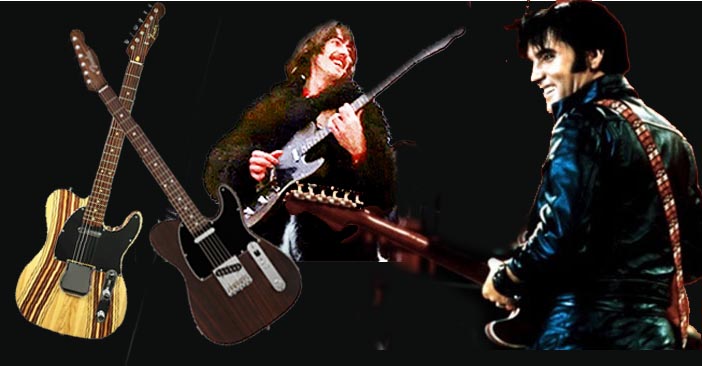
The Rosewood Tele is a sister six-string to George Harrison's iconic Rosewood Tele – and currently boasts a price tag of $295,000. (Guitarworld)
The electric guitar is one of six prototypes, and a sister six-string to the Rosewood Tele beloved by George Harrison, who used his during the Beatles’ iconic 1969 rooftop gig atop the Apple Corps headquarters in London.
The listing states that the King of Rock and Roll used the ‘68 Rosewood Tele “intermittently” for a period of a few months, but at 9lbs and 9oz, Elvis ultimately deemed it too heavy for him, and so sent it back to Eddie Miller, Fender’s Nashville rep at the time.
Currently listed for $295,000, the guitar looks to share the same spec sheet as George Harrison’s Rosewood Tele, with a chambered rosewood body and maple veneer center with a poly finish, rosewood neck and fretboard, two single-coil pickups – the bridge with staggered pole pieces and the neck featuring a chrome-plated cover – and controls pots dating back to 1964.
The guitar also comes with a letter written by Eddie Miller dated September 16, 1969, verifying its provenance, as well as its original hardshell case and additional photo documentation.
Fifty years back, on January 30, 1969, George Harrison stepped on to the roof of his group's Apple headquarters in London and plugged in a Fender Telecaster. Famously, it would be The Beatles' last ever public performance.
The ‘Stringer’ Telecaster, The history of a bona fide six-string unicorn, as told by vintage guitar expert David Davidson of New York’s Well Strung Guitars.
It’s made from pieces of alder, ash, ebony, mahogany, padauk, purpleheart and spruce. And there are a couple of woods that I can’t identify. There are about 35 different pieces of wood that make up the body.
“This guitar probably left the factory around 1975, but it was put together earlier on by Philip Kubicki in Fender’s R&D department. It was likely made around 1971, and finally completed around ’75 as the original pots date to then.
“Philip Kubicki was an apprentice to renowned guitar-builder Roger Rossmeisl, and they both worked on the George Harrison Rosewood Telecaster [made in 1968] and the Hendrix Rosewood Stratocaster prototypes.
“This guitar features a solid rosewood neck with a maple skunk stripe and headstock plug, like a regular production Rosewood Tele – not a rosewood cap, like Harrison’s prototype Rosewood Tele.
They call this guitar the Stringer because it looks like there are strings running through it – tiny little veneers that just separate the different woods.
Under normal lights, this The ‘Ghost Finish’ Telecaster appears to be an unremarkable, late-’60s blonde color. But stick it under UV light and things get trippy...
Fender tried to rise to this almost metaphysical challenge by creating so-called ‘Ghost Finish’ guitars with psychedelic designs that showed up only under UV light. (GuitarWorld)

“Right after the ’67 Summer of Love, Fender decided they were going to go and buy into this hippie dream,” David says. “So they come up with a few different designs for these ‘ghost’ or day-glo finishes that only show up under UV light. I know of only two different patterns [for six-string guitar] and there was only one of each one made.
Vanishingly rare, David Davidson of New York’s Well Strung Guitars is only aware of the existence of two prototype Teles, one of which is at Well Strung – though photos exist of a ‘Ghost Finish’ bass, too.
